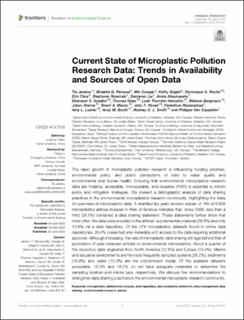| dc.contributor.author | Jenkins, Tia | |
| dc.contributor.author | Persaud, Bhaleka D. | |
| dc.contributor.author | Cowger, Win | |
| dc.contributor.author | Szigeti, Kathy | |
| dc.contributor.author | Roche, Dominique G. | |
| dc.contributor.author | Clary, Erin | |
| dc.contributor.author | Slowinski, Stephanie | |
| dc.contributor.author | Lei, Benjamin | |
| dc.contributor.author | Abeynayaka, Amila | |
| dc.contributor.author | Nyadjro, Ebenezer S. | |
| dc.contributor.author | Maes, Thomas | |
| dc.contributor.author | Thornton Hampton, Leah | |
| dc.contributor.author | Bergmann, Melanie | |
| dc.contributor.author | Aherne, Julian | |
| dc.contributor.author | Mason, Sherri A. | |
| dc.contributor.author | Honek, John F. | |
| dc.contributor.author | Rezanezhad, Fereidoun | |
| dc.contributor.author | Lusher, Amy | |
| dc.contributor.author | Booth, Andy | |
| dc.contributor.author | Smith, Rodney D. L. | |
| dc.contributor.author | Van Cappellen, Philippe | |
| dc.date.accessioned | 2022-08-05T13:39:40Z | |
| dc.date.available | 2022-08-05T13:39:40Z | |
| dc.date.created | 2022-06-30T11:18:23Z | |
| dc.date.issued | 2022 | |
| dc.identifier.citation | Frontiers in Environmental Science. 2022, 10 . | en_US |
| dc.identifier.issn | 2296-665X | |
| dc.identifier.uri | https://hdl.handle.net/11250/3010403 | |
| dc.description.abstract | The rapid growth in microplastic pollution research is influencing funding priorities, environmental policy, and public perceptions of risks to water quality and environmental and human health. Ensuring that environmental microplastics research data are findable, accessible, interoperable, and reusable (FAIR) is essential to inform policy and mitigation strategies. We present a bibliographic analysis of data sharing practices in the environmental microplastics research community, highlighting the state of openness of microplastics data. A stratified (by year) random subset of 785 of 6,608 microplastics articles indexed in Web of Science indicates that, since 2006, less than a third (28.5%) contained a data sharing statement. These statements further show that most often, the data were provided in the articles’ supplementary material (38.8%) and only 13.8% via a data repository. Of the 279 microplastics datasets found in online data repositories, 20.4% presented only metadata with access to the data requiring additional approval. Although increasing, the rate of microplastic data sharing still lags behind that of publication of peer-reviewed articles on environmental microplastics. About a quarter of the repository data originated from North America (12.8%) and Europe (13.4%). Marine and estuarine environments are the most frequently sampled systems (26.2%); sediments (18.8%) and water (15.3%) are the predominant media. Of the available datasets accessible, 15.4% and 18.2% do not have adequate metadata to determine the sampling location and media type, respectively. We discuss five recommendations to strengthen data sharing practices in the environmental microplastic research community. | en_US |
| dc.language.iso | eng | en_US |
| dc.publisher | Frontiers | en_US |
| dc.rights | Navngivelse 4.0 Internasjonal | * |
| dc.rights.uri | http://creativecommons.org/licenses/by/4.0/deed.no | * |
| dc.subject | plastic | en_US |
| dc.subject | environmental research | en_US |
| dc.subject | data sharing | en_US |
| dc.subject | data management | en_US |
| dc.subject | data availability statement | en_US |
| dc.subject | data repository | en_US |
| dc.subject | bibliometric analysis | en_US |
| dc.subject | microplastics | en_US |
| dc.title | Current State of Microplastic Pollution Research Data: Trends in Availability and Sources of Open Data | en_US |
| dc.title.alternative | Current State of Microplastic Pollution Research Data: Trends in Availability and Sources of Open Data | en_US |
| dc.type | Peer reviewed | en_US |
| dc.type | Journal article | en_US |
| dc.description.version | publishedVersion | en_US |
| dc.rights.holder | Copyright © 2022 Jenkins, Persaud, Cowger, Szigeti, Roche, Clary, Slowinski, Lei, Abeynayaka, Nyadjro, Maes, Thornton Hampton, Bergmann, Aherne, Mason, Honek, Rezanezhad, Lusher, Booth, Smith and Van Cappellen. This is an openaccess article distributed under the terms of the Creative Commons Attribution License (CC BY). The use, distribution or reproduction in other forums is permitted, provided the original author(s) and the copyright owner(s) are credited and that the original publication in this journal is cited, in accordance with accepted academic practice. No use, distribution or reproduction is permitted which does not comply with these terms. | en_US |
| dc.source.pagenumber | 10 | en_US |
| dc.source.volume | 10 | en_US |
| dc.source.journal | Frontiers in Environmental Science | en_US |
| dc.identifier.doi | 10.3389/fenvs.2022.912107 | |
| dc.identifier.cristin | 2036275 | |
| dc.relation.project | Norges forskningsråd: 301157 | en_US |
| dc.relation.project | Norges forskningsråd: 312262 | en_US |
| dc.relation.project | Norges forskningsråd: 295174 | en_US |
| dc.source.articlenumber | 912107 | en_US |
| cristin.ispublished | true | |
| cristin.fulltext | original | |
| cristin.qualitycode | 1 | |

